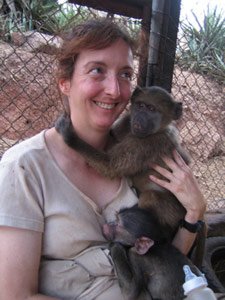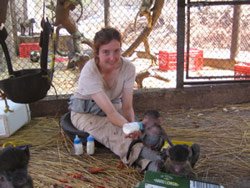IF YOU LOVE AND LIKE TO VOLUNTEER WITH ANIMALS, CONSIDER CARE!
CARE takes in and rehabilitates orphan and mistreated Chacma Baboons. From as young as 6 weeks, to the mature former lab animals who are now permanent residents, it is life changing for the volunteers who come, learn, and begin to care for the baboons.
Daily routine begins at 7am with the first round of bottles for all the enclosures with under 2 year olds. The morning progresses with food processing for the mature solo adults and more bottle for the little ones. There are usually two rotations into enclosures with one and two year olds and then lunch. Afternoons include some general lodging cleaning, possibly cooking for the volunteer group, and more play ground monitoring for the baboons. The day ends around 5pm with final clean up, last bottles and putting the littlest to bed.
YOU WILL BE VERY REMOTE (one possible trip to town per week, and no TV) so evening activities include personal laundry, long discussions over dinner with the volunteers and staff, watching the sun go down, listening to the night animals come out, and reading. At times there can be unexpected things living close to or around you. If you require absolute cleanliness and not furry or crawling critters near you, this may not be the volunteer placement for you.
What you lack in nightlife is amply compensated by your endearing and mischievous charges during the day. The young baboons are delightful, infuriating, needy, confident, and as energetic as any two-year old who as been fed exclusively caffeine and sugar. Expect to have your hair pulled, pockets picked, clothes dirty with all manner of body fluids, nipped and totally enthralled with the baboons.
Also expect your heart to expand and become overwhelmed with the love and compassion for these little charmers who come to you for assistance with their fights, cuddling when they are hurt, naps in your lap and mutual grooming. (Luckily, they never found any nits on me or I on them!)
During the mandatory 4-week minimum, you can expect one full weekend day off and some afternoons. During that one day off, there is a chance for a game drive in the nearby Kruger National Park (for a fee) where you can see most if not all of the big 5.
At times, the work is more mentally taxing than physically.
Accommodations are single sex dorms with shared bathrooms and showers. Food if brought in weekly and you are assigned cooking and clean up on a rotation with all the other volunteers. Food was very basic, so most of our group sent a small amount of personal money with the shoppers for alcohol, treats like candy, and bottled water. The water on site was potable, but most of us preferred bottled water. There can be as many as 20 volunteers from North America, Australia, Europe and Africa, mainly women, but some men as well.
You are in the middle of a wildlife reserve with wild troops of baboons and other species free roaming in the compound. The buildings and animal enclosures have electrified perimeters, but at night, you are safe indoors.
You will be working with WILD ANIMALS no matter how small and therefore; common sense and awareness are your best guides for safety. You are trained and monitored as you begin to interact with the baboons and after they know and trust you, it becomes much easier for you and them.
You may see the full circle of life from copulation and perhaps death during your time among the baboons and the other wildlife in the surrounding area. Not every baboon that arrives is eventually returned to the wild, although that is the goal. Some injuries, mentally or physically, are just too deep, so be prepared for whatever comes up.
I rated it midrange on social impact and social networking because it is located so remotely and interaction with people other than the local staff is minimum. That in NO WAY detracts from the value of this volunteer program. As with many animal related non-profits, expenses are high for things like new enclosures, food and medical supplies, and the expenses for the local workers who do the BULK of the hard physical labor around the facility. For the FUN rating, FUN is in the eye of the beholder. I found it incredibly fun and fulfilling. I can't answer for you.
Would I do it again? You bet. Do I think they used my time and money well? You bet! Will I ever forget them? NO WAY!












